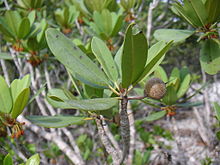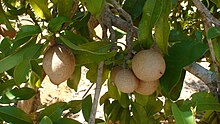Manilkara
| Manilkara | |
|---|---|

| |
| Manilkara jaimiqui ssp. emarginata branch with developing fruit | |
| Scientific classification | |
| Kingdom: | Plantae |
| Clade: | Tracheophytes |
| Clade: | Angiosperms |
| Clade: | Eudicots |
| Clade: | Asterids |
| Order: | Ericales |
| Family: | Sapotaceae |
| Subfamily: | Sapotoideae |
| Tribe: | Sapoteae |
| Genus: | Manilkara Adans., conserved name[1] |
| Type species | |
| M. kauki | |
| Synonyms | |
| |
Manilkara is a genus of trees in the family Sapotaceae. They are widespread in tropical and semitropical locations, in Africa, Madagascar, Asia, Australia, and Latin America, as well as various islands in the Pacific and in the Caribbean.[4] A close relative is the genus Pouteria.
Trees of this genus yield edible fruit, useful wood, and latex. The best-known species are M. bidentata (balatá), M. chicle (chicle) and M. zapota (sapodilla). M. hexandra is the floral emblem of Prachuap Khiri Khan Province in Thailand, where it is known as rayan. M. obovata shares the vernacular name of African pear with another completely different species, Dacryodes edulis, and neither should be confused with Baillonella toxisperma, known by the very similar name, African pearwood.
The generic name, Manilkara, is derived from manil-kara, a vernacular name for M. kauki in Malayalam.[5]
Manilkara trees are often significant, or even dominant species in their native ecosystems, such as East Deccan dry evergreen forests, Central American premontane tropical wet forests, or together with Cynometra, in the Arabuko Sokoke National Park.
Manilkara fruit are an important food item for various frugivores, in particular birds. The red fruit bat (Stenoderma rufum) is the primary – and possibly the only – seed disperser of M. bidentata in parts of the Caribbean. , a species of peacock mite, was described from a sapodilla tree.
Several species are endangered due to overexploitation and habitat destruction. M. gonavensis of Haiti and M. spectabilis of Costa Rica are almost extinct.
Selected species[]
These species are among those included in the genus Manilkara:[6][7][8]
|
(Engl. & K.Krause) H.J.Lam |
Ducke |

References[]
| Wikimedia Commons has media related to Manilkara. |
| Wikispecies has information related to Manilkara. |
- ^ a b Fam. Pl. (Adanson) 2: 166, 574. 1763 [Jul-Aug 1763] "Plant Name Details for Genus Manilkara". IPNI. Retrieved December 23, 2009.
Nomenclatural Notes: nom. cons. Type Name: M. kauki (Linnaeus) Dubard (Mimusops kauki Linnaeus) (typ. cons.) ; basionym of: Sapotaceae Mimusops subgen. Manilkara (Adans.) Pierre & Urb., Symb. Antill. (Urban). 5: 162. 1904
- ^ GRIN (March 31, 2009). "Achras information from NPGS/GRIN". Taxonomy for Plants. National Germplasm Resources Laboratory, Beltsville, Maryland: USDA, ARS, National Genetic Resources Program. Archived from the original on November 1, 2012. Retrieved December 23, 2009.
Comment: a rejected (nom. rej.), heterotypic synonym (Vienna ICBN Art. 14.4 & App. III) of Manilkara Adans., nom. cons.
- ^ Gard. Dict. Abr., ed. 4. [unpaged]. 1754 [28 Jan 1754] "Plant Name Details for Genus Sapota". IPNI. Retrieved December 23, 2009.
Nomenclatural Notes: nom. illeg. nom. superfl. Achras Linnaeus (1753).
- ^ Kew World Checklist of Selected Plant Families
- ^ Quattrocchi, Umberto (2000). CRC World Dictionary of Plant Names. Vol. III: M-Q. CRC Press. p. 1609. ISBN 978-0-8493-2677-6.
- ^ GRIN. "Species in GRIN for genus Manilkara". Taxonomy for Plants. National Germplasm Resources Laboratory, Beltsville, Maryland: USDA, ARS, National Genetic Resources Program. Archived from the original on September 24, 2015. Retrieved December 23, 2009.
- ^ M. obovata listed in Mabberley's The Plant Book and also at Encyclopedia of Life
- ^ "Query Results for Genus Manilkara". IPNI. Retrieved December 24, 2009.
- Manilkara
- Sapotaceae genera